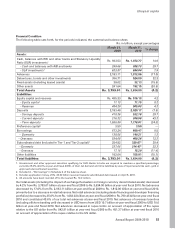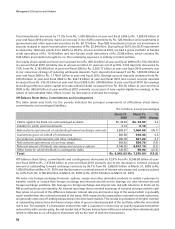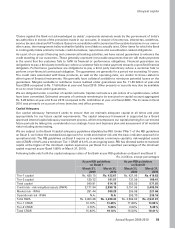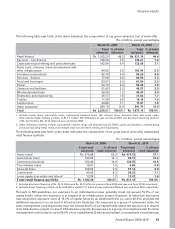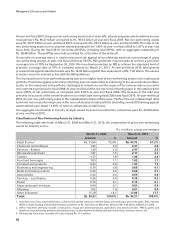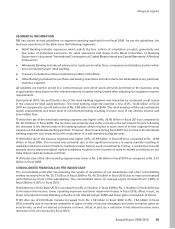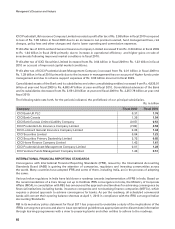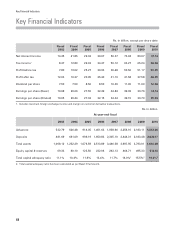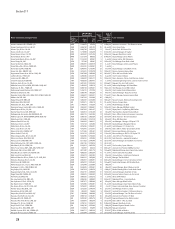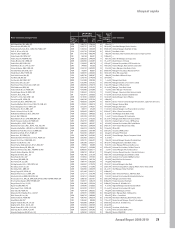ICICI Bank 2010 Annual Report Download - page 65
Download and view the complete annual report
Please find page 65 of the 2010 ICICI Bank annual report below. You can navigate through the pages in the report by either clicking on the pages listed below, or by using the keyword search tool below to find specific information within the annual report.
Classification of Loans
We classify our assets as performing and non-performing in accordance with RBI guidelines. Under these guidelines,
an asset is classified as non-performing if any amount of interest or principal remains overdue for more than 90
days, in respect of term loans. In respect of overdraft or cash credit, an asset is classified as non-performing if the
account remains out of order for a period of 90 days and in respect of bills, if the account remains overdue for
more than 90 days. In compliance with regulations governing the presentation of financial information by banks,
we report non-performing assets net of cumulative write-offs in our financial statements.
RBI has separate guidelines for restructured loans. A fully secured standard asset can be restructured by re-
schedulement of principal repayments and/or the interest element, but must be separately disclosed as a
restructured asset. The diminution in the fair value of the loan, if any, measured in present value terms, is either
written off or a provision is made to the extent of the diminution involved. Similar guidelines apply to sub-standard
loans. The sub-standard or doubtful accounts which have been subject to restructuring, whether in respect of
principal installment or interest amount are eligible to be upgraded to the standard category only after the specified
period, i.e., a period of one year after the date when first payment of interest or of principal, whichever is earlier,
falls due, subject to satisfactory performance during the period. In December 2008, RBI provided a one-time
relaxation to banks to restructure the loans classified as real estate exposures. Similarly, banks were also permitted
to undertake, for accounts that were previously restructured, a second restructuring without downgrading the
account to the non-performing category. These relaxations were available till June 30, 2009. RBI also permitted
banks to restructure as standard accounts all eligible accounts which met the basic criteria for restructuring, and
which were classified as standard at September 1, 2008 irrespective of their subsequent asset classification. This
relaxation was subject to banks receiving an application from the borrower for restructuring the advance on or
before March 31, 2009 and the implementation of the restructuring the package within 120 days from the date
of receipt of the application. During fiscal 2010, we restructured loans aggregating Rs. 53.08 billion extended to
3,933 borrowers which included 3,875 retail mortgage borrowers (including eight borrowal accounts restructured
for a second time with asset classification benefit up to June 30, 2009, aggregating to Rs. 24.29 billion). During
fiscal 2009, we had restructured loans aggregating Rs. 11.31 billion.
The following table sets forth, at March 31, 2009 and March 31, 2010, information regarding the classification of
our gross customer assets (net of write-offs, interest suspense and derivatives income reversal).
Rs. in billion
March 31, 2009 March 31, 2010
Standard assets Rs. 2,316.10 Rs. 2,057.29
Of which: Restructured loans 61.27 55.87
Non-performing assets 98.03 96.27
Of which: Sub-standard assets 61.67 50.20
Doubtful assets 31.04 40.30
Loss assets 5.32 5.77
Total customer assets1Rs. 2,414.13 Rs. 2,153.56
1. Customer assets include advances, lease receivables and credit substitutes like debentures and bonds but exclude preference shares.
2. All amounts have been rounded off to the nearest Rs. 10.0 million.
The following table sets forth, at the dates indicated, information regarding our non-performing assets (NPAs).
Rs. in billion, except percentages
Year ended Gross NPA1Net NPA Net customer
assets % of Net NPA to Net
customer assets2
March 31, 2008 75.88 35.64 2,384.84 1.49%
March 31, 2009 98.03 46.19 2,358.24 1.96%
March 31, 2010 96.27 39.01 2,091.22 1.87%
1. Net of write-offs, interest suspense and derivatives income reversal.
2. Customer assets include advances and credit substitutes like debentures and bonds but exclude preference shares.
3. All amounts have been rounded off to the nearest Rs. 10.0 million.
63
Annual Report 2009-2010
khayaal aapka






